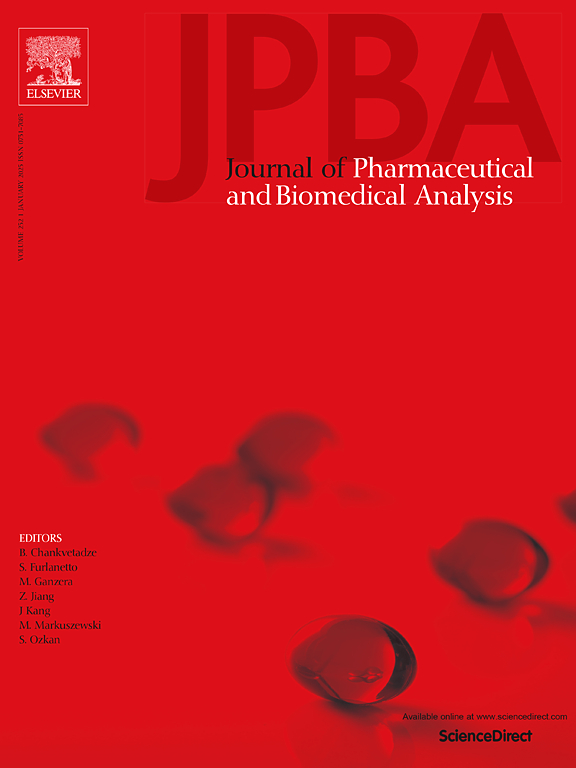恩杂鲁胺的杂质谱分析和稳定性分析:鉴定、遗传毒性评估和开发关键杂质的UHPLC方法
IF 3.1
3区 医学
Q2 CHEMISTRY, ANALYTICAL
Journal of pharmaceutical and biomedical analysis
Pub Date : 2025-04-26
DOI:10.1016/j.jpba.2025.116926
引用次数: 0
摘要
本研究旨在综合评价和控制enzalutamide的杂质谱,enzalutamide是一种雄激素受体信号抑制剂,用于治疗转移性去势抵抗前列腺癌。利用液相色谱-质谱法(LC-MS),在合成方法开发和应力测试研究过程中,根据其质量电荷比(m/z)鉴定了20种杂质。根据ICH M7指南对这些化合物进行分类,发现了两种潜在的基因毒性杂质:Enzal-2(4-异硫氰酸酯-2-(三氟甲基)苯腈),由于其异硫氰酸基团而被归类为3类杂质;Enzal-2A(4-氨基-2-(三氟甲基)苯腈),由于Ames测试结果呈阳性而被归类为2类杂质。根据毒理学关注阈值(TTC)为1.5 µg/d, Enzal-2和Enzal-2A的最大日剂量为160 mg,为降低安全风险,确定了Enzal-2和Enzal-2A的控制限值为9.4 ppm。Enzal-2和Enzal-2A都被确定为过程相关杂质,其中Enzal-2A也被认为是水解降解产物。建立并验证了特异的超高效液相色谱(UHPLC)方法,用于精确、准确、稳健地定量enzalutamide、Enzal-2、Enzal-2A及相关杂质。这些方法适用于各种应激条件下的恩杂鲁胺样品,包括高温、日光、紫外线辐射、氧化、中性、碱性和酸性环境,以及加速和长期稳定性测试。研究结果强调了综合杂质分析和验证分析方法的重要性,以确保恩杂鲁胺的安全有效生产、质量控制和使用。本文章由计算机程序翻译,如有差异,请以英文原文为准。
Impurity profiling and stability analysis of enzalutamide: Identification, genotoxicity assessment, and development of UHPLC methods for critical impurities
This study aims to comprehensively evaluate and control the impurity profile of enzalutamide, an androgen receptor signaling inhibitor used to treat metastatic castration-resistant prostate cancer. Using liquid chromatography-mass spectrometry (LC-MS), twenty impurities were identified based on their mass-to-charge ratios (m/z) during synthetic method development and stress testing studies. Classification of these compounds according to ICH M7 guidelines revealed two potentially genotoxic impurities: Enzal-2 (4-isothiocyanato-2-(trifluoromethyl)benzonitrile), classified as a Class 3 impurity due to its isothiocyanate group, and Enzal-2A (4-amino-2-(trifluoromethyl)benzonitrile), classified as a Class 2 impurity due to a positive Ames test result. Based on the threshold of toxicological concern (TTC) of 1.5 µg/day and the maximum daily dose of enzalutamide of 160 mg, a control limit of 9.4 ppm was established for Enzal-2 and Enzal-2A to mitigate safety risks. Both Enzal-2 and Enzal-2A were identified as process-related impurities, with Enzal-2A also recognized as a hydrolysis degradation product. Specific ultra-high-performance liquid chromatography (UHPLC) methods were developed and validated for the precise, accurate, and robust quantification of enzalutamide, Enzal-2, Enzal-2A, and related impurities. These methods were applied to enzalutamide samples subjected to various stress conditions, including elevated temperature, daylight, UV radiation, and exposure to oxidative, neutral, alkaline, and acidic environments, as well as under accelerated and long-term stability testing. The findings underscore the importance of comprehensive impurity profiling and validated analytical methods to ensure the safe and effective manufacture, quality control, and use of enzalutamide.
求助全文
通过发布文献求助,成功后即可免费获取论文全文。
去求助
来源期刊
CiteScore
6.70
自引率
5.90%
发文量
588
审稿时长
37 days
期刊介绍:
This journal is an international medium directed towards the needs of academic, clinical, government and industrial analysis by publishing original research reports and critical reviews on pharmaceutical and biomedical analysis. It covers the interdisciplinary aspects of analysis in the pharmaceutical, biomedical and clinical sciences, including developments in analytical methodology, instrumentation, computation and interpretation. Submissions on novel applications focusing on drug purity and stability studies, pharmacokinetics, therapeutic monitoring, metabolic profiling; drug-related aspects of analytical biochemistry and forensic toxicology; quality assurance in the pharmaceutical industry are also welcome.
Studies from areas of well established and poorly selective methods, such as UV-VIS spectrophotometry (including derivative and multi-wavelength measurements), basic electroanalytical (potentiometric, polarographic and voltammetric) methods, fluorimetry, flow-injection analysis, etc. are accepted for publication in exceptional cases only, if a unique and substantial advantage over presently known systems is demonstrated. The same applies to the assay of simple drug formulations by any kind of methods and the determination of drugs in biological samples based merely on spiked samples. Drug purity/stability studies should contain information on the structure elucidation of the impurities/degradants.

 求助内容:
求助内容: 应助结果提醒方式:
应助结果提醒方式:


